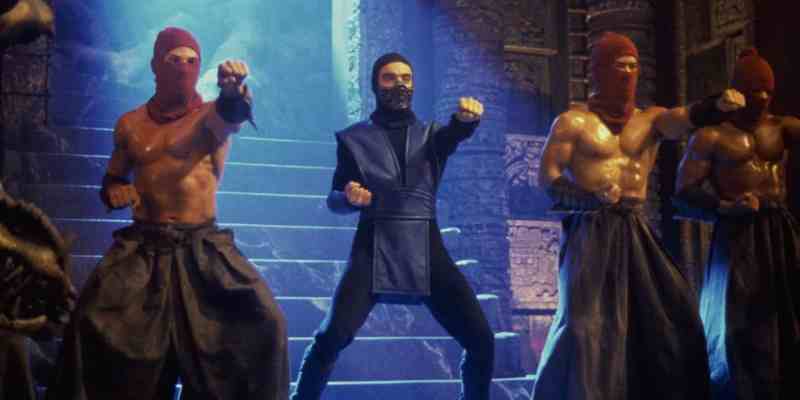Before the New Line Cinema logo has fully materialized, 1995’s Mortal Kombat lets audiences know what awaits them. “MORTAL KOMBAT!” screams a voice, as the techno dance theme song roars to life for the first – but far from the last – time over the movie’s 102-minute runtime.
Mortal Kombat starts as it means to go on. It is a very silly movie, but strangely earnest in its own way. The film is not beholden to its video game roots, but it is also completely unashamed of them. This is a movie that seems to have spent most of its modest budget on keeping the fog machine working, but which takes incredible glee in having evil sorcerer Shang Tsung (Cary-Hiroyuki Tagawa) shout catchphrases from the game, like “Finish him!”, “Fatality!”, and “Flawless victory!”
Mortal Kombat is the second feature film from director Paul W.S. Anderson. Anderson has worked steadily since the 1990s, but his filmography has enjoyed something of a reappraisal in the past decade. Ignatiy Vishnevetsky praised Anderson’s “inventive — and sometimes even poetic — use of space.” Callum Marsh has classified Anderson as a “vulgar auteur,” placing his work alongside that of directors like Tony Scott, Paul Verhoeven, and John Carpenter.
A large part of Anderson’s appeal is how unashamed he is of the material with which he works. Richard Newby argues that Anderson understands his “films exist on the same level as the dog-eared comics you used to keep under your bed, the scratched game disc your parents hid from you, and the abridged novels you got for a bargain.” R. Emmet Sweeney contends that Anderson’s work is “often overlooked due to the critically reviled nature of video game movies.”

As if to underscore his point, most of the praise for Anderson’s Mortal Kombat tends to be framed as backhanded compliments. For example, Jordan Crucchiola has called it the “least bad” video game adaptation. However, Anderson took the task of adapting the video game seriously. “I was very aware of the phenomenon that Mortal Kombat was, and I was also kind of steeped in the backstory of the characters,” Anderson recalls. “I knew what Mortal Kombat could be.”
Anderson’s Mortal Kombat is unapologetically a B-movie. The film was shot for a paltry $18M. This was a steal by the standards of the time; Clint Eastwood’s weepy romance The Bridges of Madison County cost $22M and didn’t feature a single animatronic monster or computer-generated lizard person. Even fellow vulgar auteur Tony Scott couldn’t get his submarine thriller Crimson Tide made for less than $50M. To be fair, Mortal Kombat doesn’t try to fool anybody about its budget.
Christopher Lambert is the biggest star in Mortal Kombat, playing Raiden. Lambert was (and is) best known for his work on the Highlander franchise. A lot of the special effects look like they might have been lifted directly from the video game itself, especially the presentation of the character Reptile and some of the green screen work around Shang Tsung. The film does feature a number of impressive soundstages but uses them repeatedly in order to maximize the investment.
There’s something knowing in all of this. Even the characters understand the absurdity of the plot, which is essentially a vaguely mystical riff on the classic martial arts movie template established by Enter the Dragon. When Raiden outlines the movie’s stakes to the cast on a set that Kano (Trevor Goddard) later fairly describes as “a crummy-looking boat,” Sonya Blade (Bridgette Wilson) asks, “A handful of people on a leaky boat are going to save the world?” Raiden responds, “Exactly.”

Mortal Kombat understands what the audience is here for and knows how best to deliver it. The film’s plot is… far from robust, but it’s transparently a vehicle for a set of character-driven showdowns. When Anderson is not as proficient a hand-to-hand combat director as someone like Gareth Evans, he knows enough to make each fight unique in terms of geography and character dynamics. Mortal Kombat is many things, but it is never dull.
This feels true to the spirit of the game in all its pulpy adolescent glory. Mortal Kombat understands how much the audience wants to see Johnny Cage (Linden Ashby) deploy his “ball-breaker” move. It’s more than an in-joke; the “ball-breaker” was so important to the developers of Mortal Kombat that it was the only move with character-specific responses. In the game, Johnny couldn’t use it against Sonya. Interestingly, he could use it against Goro, but Goro doesn’t physically react to it, unlike in the film.
Mortal Kombat features the four-armed monstrous character of Goro (body by Tom Woodruff, Jr., voice by Kevin Michael Richardson) realized through animatronics. It’s an occasionally goofy effect, particularly when Goro is required to speak. However, it’s also strangely charming, feeling like an appropriate way to bring the character to the screen. In the video game, Goro had been inspired by the stop-motion figures used in classic films such as Jason and the Argonauts and Clash of the Titans.
Mortal Kombat never takes itself too seriously, and it works on those terms. Its leading trio of human characters are fairly generic, and the script makes no real effort to shade or complicate them. Liu Kang (Robin Shou) seeks to avenge the death of his brother Chan Kang (Steven Ho) at the hands of Shang Tsung. Sonya Blade is also seeking revenge, against Kano for the murder of her partner. To balance these two out, Johnny Cage is the broad comic relief.

Much has been made of Johnny Cage’s absence from the casting announcements and the trailer for Simon McQuoid’s upcoming Mortal Kombat reboot. After all, both Liu Kang and Sonya Blade are featured prominently, played by Ludi Lin and Jessica McNamee. While it makes sense that Cage wouldn’t be the central focus of a Mortal Kombat reboot, his absence from the reboot feels telling. The reimagined Mortal Kombat doesn’t look to have much room for broad comic relief.
The trailer for the HBO Max release suggests a movie that takes itself much more seriously than Anderson’s effort. If anything, the movie appears to take its cues from modern superhero films; Sub-Zero (Joe Taslim) uses his “superhuman abilities” to “tear through” a trained military squad in seconds, as Sonya Blade narrates a secret history that has been earnestly uncovered. Characters reveal new abilities like they’re auditioning for X-Men, as the trailer promises the arrival of “a new age.”
To be fair, this is part of a larger trend of the “superherofication” of pop culture, reflecting the success of the superhero genre and the gravity that it exerts on other types of story; the western and the musical were similarly influential in their golden ages. It is an unspoken assumption that many of the biggest and most successful movies of the modern age are superhero movies, so of course those movies that want to be as big and as successful will look like superhero movies.

In Fast & Furious Presents: Hobbs & Shaw, the villainous Brixton Lore (Idris Elba) turns himself into a super-soldier like Captain America. He even calls himself “Black Superman.” Similarly, Frozen and Frozen II find Elsa (Idina Menzel) using her ice powers very similarly to ice-themed superheroes like Frozone (Samuel L. Jackson) from The Incredibles and Iceman (Shawn Ashmore) from the X-Men franchise. Still, the trailer for the upcoming Mortal Kombat takes itself very seriously.
The budget of the upcoming Mortal Kombat is unknown, although Scott Mendelson estimates it at around $75M. Even adjusting for inflation, that’s multiples of Anderson’s budget. While Anderson’s Mortal Kombat was successful enough at the box office to spawn a sequel, the dire Annihilation, actor Ludi Lin has suggested that the reboot is designed to “build a universe of Mortal Kombat” from the outset.
Paul W.S. Anderson’s Mortal Kombat was an odd film, but one that fit with the pulp sensibility of the game. In its own way, it captured the visceral thrill and goofy sensibility of the fighting game, never taking itself too seriously to have a little fun. It’s a shame the reboot looks nowhere near as unique.
